Thermal-Infrared Radiative Effects of Various Urban Materials Upon Vegetation
Advanced Remote
Sensing Course Project
Western Michigan University
Completed: April 19, 2000
Amy Heist
Robert Ruhf
Roosevelt Hampton
Wattanachai Nirundorn
Email comments / questions to x98ruhf@netscape.net
DOWNLOAD THIS DOCUMENT (.PDF FORMAT)
The urban heat island (UHI) is a phenomenon that has been recognized since the turn of the 20th century. It has been shown that air temperatures are higher in most mid- and high-latitude cities than in the surrounding rural areas. Urban climates therefore differ from rural climates (Taha, pg.99). A heat island can occur at a broad range of scales. It can manifest itself around a single structure, a small vegetative canopy, or a large city section (Taha, 99). The effect of the UHI is more pronounced during the spring and summer than in the winter months, and is attributed mainly to differences in the surface energy balance (Melhuish and Pedder, 121). Variations in the surface energy balance result from "...modifications in morphological and physical features of the urban surface, and its energetic conditions, which consequently and unintentionally modify radiation, heat and water balance in urban areas (Yamashita and Sekine, 279)." Structural building materials therefore have an effect on the urban climate, and (depending on the composition of the materials) these effects may be quite profound.
Vegetation may be used in urban environments to moderate the effects of the UHI, as vegetation absorbs radiation and utilizes it for natural processes. A study conducted by Roni Avissar found that vegetation can significantly effect the temperature, wind, precipitation, and moisture regime of urbanized areas (Avissar, 437). It is therefore important to determine which urban materials perpetuate the UHI effect and how vegetation may mitigate the effects. Our study therefore attempts to examine the thermal-infrared radiative effects of various urban materials upon vegetation.
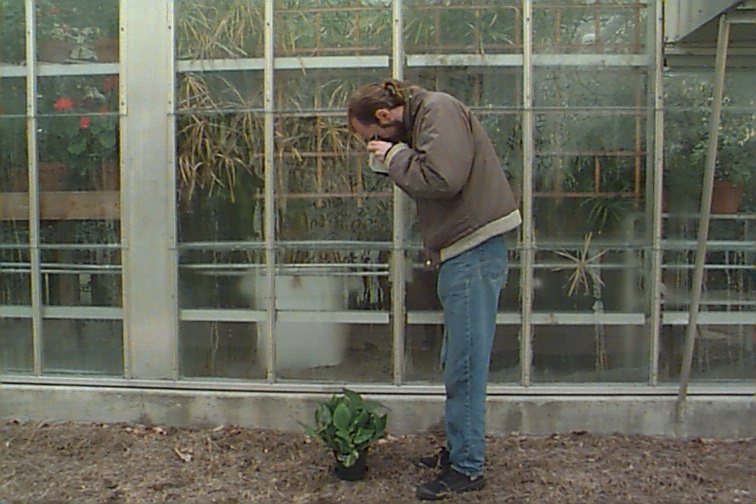
The following items were used in our study:
1. Six plants of the species golden pothos (Epipremnun aurum scindapsus)
2. Two coolers to insulate plants from the environment until needed
3. A digital camera
4. A Minolta (TM) Cyclops radiant temperature detector (long-wave radiation)
5. A compass
The data were collected on March 30, 2000, both during the day and at night. The daytime data were collected between 12:00 noon and 12:45 p.m., and the nighttime data were collected between 9:00 p.m. and 9:45 p.m. The skies were clear during both study periods. The air temperature was 40 degrees Fahrenheit at noon, and 39 degrees Fahrenheit at 9:00 p.m.
Several buildings on the campus of Western Michigan Unviersity (located in Kalamazoo, Michigan) were chosen based on their material composition. A brick wall of light color, a side of a glass greenhouse, a concrete wall, a ceramic wall, a dark brick wall, a wooden shelter-like art work structure, and a wall consisting of a mix of conglomerate and granite were all selected. A line of trees was also chosen for the sake of comparing natural features with urban features.
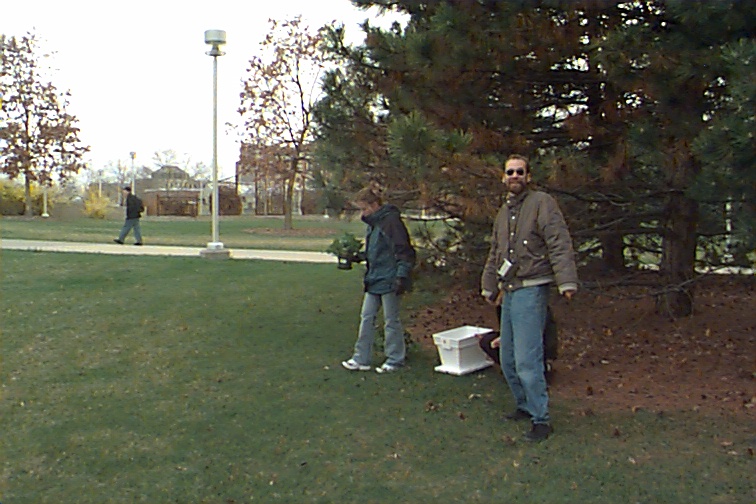
The compass was used to locate the south-facing sides of all selected structures. One plant was then placed 16 inches away from this side of the structure (hereafter referred to as "plant A"), and a second plant was placed 40 feet away (hereafter referred to as "plant B"). We waited approximately four minutes before taking readings with the Cyclops instrument. This process was performed on the south side of all seven structures, and on the south side of the line of trees. It was performed during the noon hour (day), and again during the 9:00 p.m. hour (night).
Three measurements of the radiant temperature were taken of each plant at each location, and averages of the three readings for all locations were calculated. The radiant temperature of the building's material was also determined by the same method. The digital camera was used to document the data collection procedure.
| Structure Material | Plant A Average | Plant B Average | Structure Material Average |
| brick | 62.8 | 54.9 | 87.53 |
| glass | 70.97 | 55.2 | 63.7 |
| concrete | 79.1 | 62.17 | 41.17 |
| ceramic | 62.67 | 54.67 | 62.4 |
| trees | 55.17 | 64.97 | 44.87 |
| CmG | 66.97 | 41.37 | 52.6 |
| dark brick | 70.4 | 68.87 | 91.5 |
| art work | 75.8 | 63.13 | 56.53 |
Table 2: Radiant temperature in degrees Fahrenheit (Nighttime):
| Structure Material | Plant A Average | Plant B Average | Structure Material Average |
| brick | 38.07 | 31.63 | 47.83 |
| glass | 36.3 | 29.73 | 40.4 |
| concrete | 35.97 | 31.17 | 49.4 |
| ceramic | 36.37 | 31.2 | 49.5 |
| trees | 34.03 | 27.17 | 32.7 |
| CmG | 35.3 | 33.4 | 42.9 |
| dark brick | 38.77 | 42.73 | 50.87 |
| art work | 34.13 | 31.2 | 33 |
Emissivity, or average total exitance (M), was determined from the calculated averages using the Stefan-Boltzman Equation, M = sT4, where s = 5.67 E-8 W /(m2 K4). Comparisons of M were made between the vegetation and the material for both day and night.
| Structure Material | Plant A Exitance | Plant B Exitance | Material Exitance |
| brick | 402.53 | 378.73 | 484.32 |
| glass | 428.30 | 379.62 | 405.31 |
| concrete | 455.16 | 400.59 | 339.90 |
| ceramic | 402.13 | 378.06 | 401.30 |
| trees | 379.53 | 409.26 | 350.06 |
| CmG | 415.54 | 340.44 | 372.01 |
| dark brick | 426.47 | 421.56 | 498.53 |
| art work | 444.11 | 403.55 | 383.55 |
Table 4: Average Total Exitance in W / m2 (Nighttime):
| Structure Material | Plant A Exitance | Plant B Exitance | Material Exitance |
| brick | 331.56 | 314.73 | 358.34 |
| glass | 326.87 | 309.89 | 337.81 |
| concrete | 326.00 | 313.56 | 362.80 |
| ceramic | 327.06 | 313.63 | 363.08 |
| trees | 320.93 | 303.46 | 317.48 |
| CmG | 324.24 | 319.29 | 344.62 |
| dark brick | 333.43 | 344.15 | 367.01 |
| art work | 321.19 | 313.63 | 318.26 |
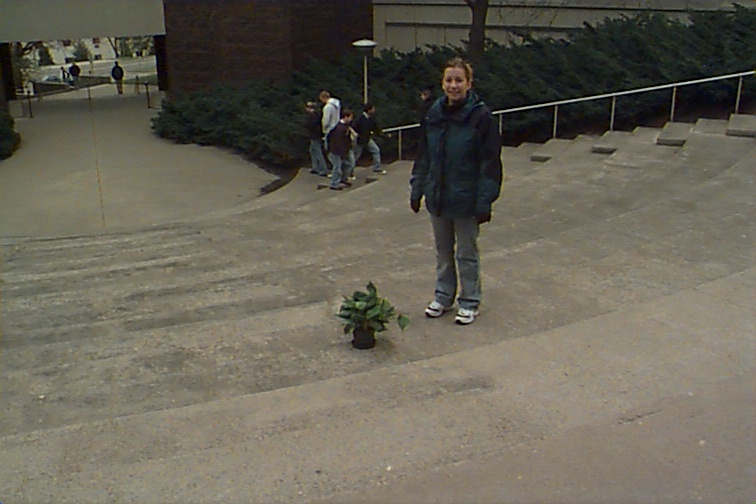
By placing two plants of the same species 16 inches and 40 feet from various buildings composed of different material, we were able to demonstrate that the building's material caused the plant 16 inches from the building to have a higher radiant temperature than the plant 40 feet from the building. The daytime radiant temperatures of the plants at both distances were higher than the nighttime radiant temperatures, and the daytime radiant temperatures of the material were higher than the nighttime radiant temperature of the material. Plant A's nighttime radiant temperature was an average of 4.7 degrees warmer than plant B. Likewise, plant A's daytime radiant temperature was an average of 10 degrees warmer than plant B. This confirmed our initial expectation that the building material would have a significant effect on vegetation.
The daytime emissivity of plant A was an average of 14.8 w/m2 higher than the building material, while the daytime emissivity of plant B was an average of 15.4 w/m2 lower than the building material. The nighttime emissivity of plant A was an average of 11.9 w/m2 lower than the building material, and the nighttime emissivity of plant B was an average of 21.8 w/m2 lower than the building material.
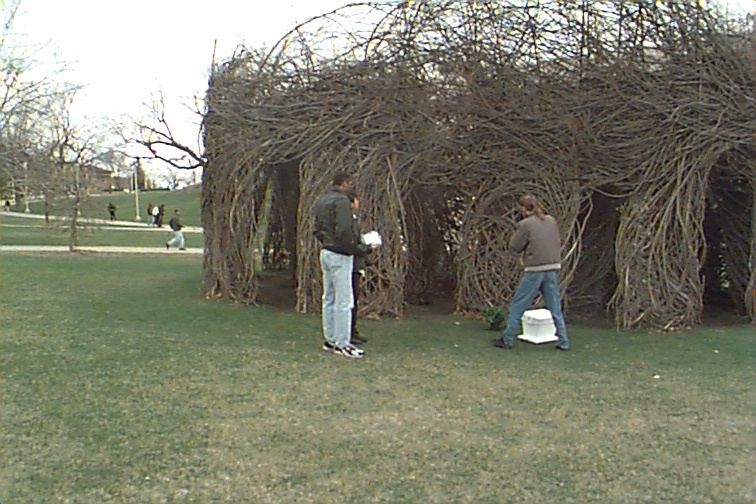
Day: We can see from the average readings that every surface, with the exception of the trees, had a positive effect on the plant during the day (Table 1, Table 3). All plants placed 16 inches away from buildings (including the shelter-like wooden artwork) had both a higher radiant temperature and a higher exitance than the plants placed 40 feet away from the surface. As expected, the plant placed 40 feet away from the trees had both a higher radiant temperature and a higher exitance than the plant placed 16 inches away from the trees. The radiant temperature of the plant near the trees averaged 55.17 degrees Fahrenheit, while the radiant temperature of the plant away from the trees (and out in the open sun) averaged 64.97 degrees Fahrenheit. This confirmed our hypothesis that the building material has a significant effect on vegetation. As was stated earlier in this paper, we refer to this effect as the urban heat island.
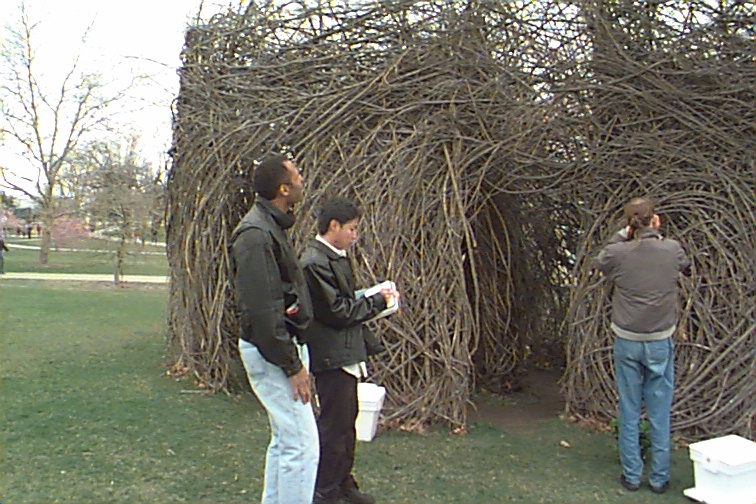
Night: Almost all of the plants placed at 16 inches had a significantly warmer radiant temperature and a significantly higher exitance at night than the plants placed at 40 feet (Table 2, Table 4). The only exception to this was in the area of the dark brick building where the plant placed at 40 feet had a warmer radiant temperature than the plant placed at 16 inches. The entire ground surface near the dark brick building was paved with cement. The plant 40 feet away from the dark brick building was therefore coming under the influence of long-wave radiation emitting from the cement. This was expected, and helps to confirm the heat island influence on vegetation.
There was one other result worth discussing. At night, the radiant temperature and the exitance of the plant placed 16 inches away from the trees was higher than the radiant temperature and the exitance of the plant placed 40 feet away from the tree at night. We initially hypothesized that there would be no significant difference between the plant placed near the trees and the plant placed away from the trees at night because the trees are natural features that are not a part of the urban heat island influence. We failed to take into consideration that the plant 40 feet away from the trees was out in the open, and would therefore loose radiation at a faster rate because there is little to prevent that radiation from escaping.
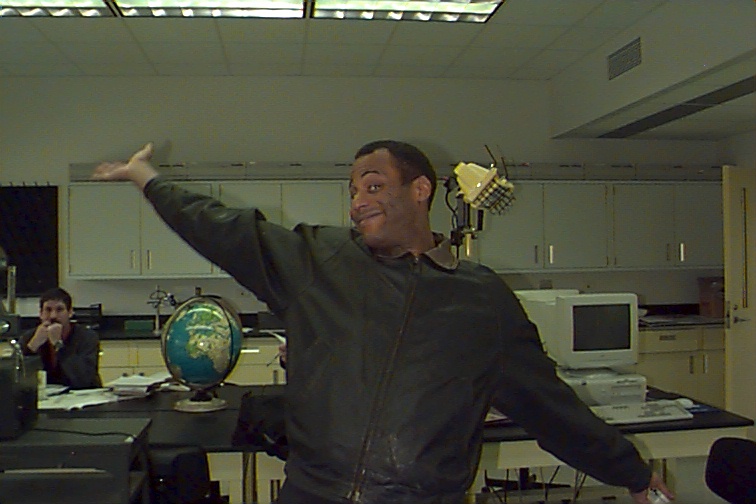
Avissar, R., 1994. "Potential Effects of Vegetation on the Urban Thermal Environment." Atmospheric Environment. Vol. 30 No. 3, pp. 437-448.
Melhuish, E., Pedder, M., 1998. "Observing an Urban Heat Island by Bicycle." Weather. Vol. 53 No. 4. pp. 121-128.
Taha, H., 1997. "Urban Climates and Heat Island: Albedo, Evapotranspiration, and Anthropogenic Heat." Energy and Buildings. Vol. 25. pp. 99-103.
Wilmers, F., 1990. "Effects of Vegetation on Urban Climate and Buildings." Energy and Buildings. Vol. 15. pp. 507-514.
Yamashita, S., Sekine, K., 1990. "Some Studies on the Earth's Surface Conditions Relating to the Urban Heat Island." Energy and Buildings. Vol. 15. pp. 279-288.